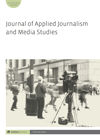
Full text loading...
 , Manar Daher2
, Manar Daher2
This interdisciplinary research aims to examine the effects of photos used in Arabic news websites on both comprehension and recall among readers. The dual-coding theory was used as a theoretical framework. The research used an experimental design of two groups to test the effects of photos on comprehension and recall of the news content included in two news websites created specifically for the experiment. Two groups of 80 university students have participated voluntarily in the experiment. The results indicated that the use of photos in the news website has increased significantly the levels of both comprehension and recall among respondents.

Article metrics loading...

Full text loading...
References


Data & Media loading...

Publication Date:
https://doi.org/10.1386/ajms_00050_1 Published content will be available immediately after check-out or when it is released in case of a pre-order. Please make sure to be logged in to see all available purchase options.